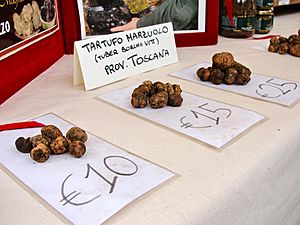Tuber borchii facts for kids
Quick facts for kids Tuber borchii |
|
|---|---|
 |
|
| At a market in Tuscany | |
| Scientific classification | |
| Genus: |
Tuber
|
| Species: |
borchii
|
| Tuber borchii | |
|---|---|
| Mycological characteristics | |
| glebal hymenium | |
| hymenium attachment is not applicable | |
| lacks a stipe | |
| ecology is mycorrhizal | |
| edibility: choice | |
The Tuber borchii, also known as the whitish truffle or bianchetto truffle, is a small, tasty type of truffle. It is great for cooking and is quite common to find.
What is a Whitish Truffle?
How the Whitish Truffle Got Its Name
This truffle was named by a scientist called Carlo Vittadini. He used the Latin word borchii. This name honors Michael Johann von der Borch, a naturalist who first described this truffle in 1780.
What Does It Look Like?
The whitish truffle is usually about 1 to 3 centimeters (about 0.4 to 1.2 inches) in size. It is round and looks a bit like a bumpy potato. When it is young, its outside is slightly fuzzy and white. As it gets older, it becomes smooth and turns a reddish-brown color with darker marks.
Inside, the truffle is firm. When it's young, the inside is whitish. As it ages, it turns a light brown or pinkish-brown. You can see white, wiggly lines running through the inside.
Smell and Taste
Young whitish truffles have a nice smell. But when they get older, their smell can become a bit strong, like kitchen gas. Some people say it tastes like garlic, while others think it tastes like hazelnuts.
Tiny Details: Spores
If you look at the truffle under a microscope, you can see its spores. These spores are oval or round and are brown. They help the truffle reproduce.
Similar Truffles
There are other truffles that look similar to the whitish truffle. These include Tuber asa, Tuber oligospermum, and Tuber puberulum. Scientists can tell them apart by looking closely at their spores.
Where Whitish Truffles Grow
Their Favorite Homes
Whitish truffles often grow in forests with oak trees. Sometimes, they can also be found under conifer trees like pines. Like most truffles, they grow underground. They are not usually very deep, and sometimes you can even see older ones poking out of the ground.
When and Where to Find Them
You can find these truffles from winter to early summer, usually from December to June. They like to grow in areas near the coast or in low-lying places, between 200 and 1,000 meters (about 650 to 3,300 feet) above sea level.
These truffles are very good at adapting to different places. They prefer sandy soils that have a lot of lime, which are common near coasts. But they can also grow in the same places as the famous black truffle (Tuber melanosporum), even at higher altitudes. They grow best in soils that are slightly alkaline, but they can also grow in slightly acidic soils.
Where They Are Found in Europe
You can find whitish truffles all over Europe. They grow from Finland down to Italy (in regions like Tuscany, Abruzzo, Romagna, Umbria, Marche, Molise, and Sicily). They are also found in the Iberian Peninsula (including Andalusia, Portugal, and Castile and León), and from Ireland and Great Britain to Hungary and Poland.
Using and Growing Whitish Truffles
Harvesting Time and Value
Whitish truffles are usually collected from winter to spring. In Italy, this is from mid-January to the end of April. This is different from the very expensive Tuber magnatum truffle, which is collected in autumn and early winter. Whitish truffles can sell for about 300 to 400 euros per kilogram.
Why People Grow Them
Even though the whitish truffle is not as famous as the Tuber magnatum or Tuber melanosporum, it is still grown for several good reasons:
- It starts producing truffles quickly in new farms, sometimes as early as 4 years after planting.
- It can grow well in many different environments.
- It is not very picky about the types of trees it grows with.
- It is very good at competing with other fungi, especially in young truffle farms.
Growing Truffles in North Carolina
A company called Mycorrhiza Biotech in Gibsonville, North Carolina has been working on ways to grow bianchetto truffles for sale. Their CEO, Nancy Rosborough, said that in 2021, their truffle farms produced a lot of truffles, possibly as much as 200 pounds!

